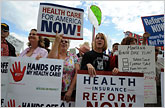 Left to right: Tom Green County Jail via Getty Images, Ed Andrieski/Associated Press Colleen R. LaRose, the self-described “Jihad Jane,” and Najibullah Zazi, who pleaded guilty to terrorism charges.
Left to right: Tom Green County Jail via Getty Images, Ed Andrieski/Associated Press Colleen R. LaRose, the self-described “Jihad Jane,” and Najibullah Zazi, who pleaded guilty to terrorism charges. Several terrorism cases in recent months have involved American citizens or residents, many from backgrounds that do not fit the expected profile of a jihadist.
The cases of Najibullah Zazi, Colleen R. LaRose (“Jihad Jane”) and David Headley suggest that radicalization in the U.S. is increasing. Another American, Jamie Paulin-Ramirez, was detained and released last week in connection to a terrorism case in Ireland.
On Thursday, Ms. LaRose pleaded not guilty to federal charges of conspiracy to kill a Swedish cartoonist, who had drawn the prophet Muhammad with a dog’s body. Mr. Headley, a Chicago businessman, pleaded guilty on Thursday to helping to provide surveillance for the Mumbai attacks in 2008.
How significant is the radicalization threat? What are the factors driving this trend?
- Barak Mendelsohn, political science professor
- Lydia Khalil, counterterrorism analyst
- Rick Nelson and Ben Bodurian, C.S.I.S.
- Peter Chalk, RAND Corp.
The Psychological Dimension

Barak Mendelsohn is an assistant professor at Haverford College and a senior fellow at the Foreign Policy Research Institute. He is the author of “Combating Jihadism: American Hegemony and Interstate Cooperation in the War on Terrorism.”
The growing number of stories about Americans involved in terrorist plots is indeed alarming. The belief that the successful integration of Muslims into American society will prevent the rise of homegrown terrorism turned out to be false.
As troubling as some attacks are, they do not have inherent strategic value.
Surprisingly, it comes at a time when the U.S. appears to be on its way out of Iraq, and the U.S. president is still considerably popular among the people of the Middle East. The incongruity between the common claims about the causes of radicalization and reality requires a more circumspect view of this phenomenon.
We should acknowledge that radicalization may stem from numerous disparate factors. Many times its reasons are idiosyncratic and reflect psychological factors at least as much (and probably more) as political or ideological ones.
The Same Path

Lydia Khalil is an International Affairs Fellow at the Council on Foreign Relations and a former counterterrorism analyst for the New York Police Department.
White, female, middle-aged and living in Pennsylvania doesn’t fit your typical terrorist profile. Yet this describes Colleen LaRose or “Jihad Jane.” Her background dispels the notion once and for all that you can profile a terrorist. But even though her story may be atypical, her path is anything but.
These extremists all stumbled upon a radical ideology that provided them with easy answers.
Ms. LaRose’s case is one in a string of cases of homegrown Islamic extremists, including Najibullah Zazi who was arrested for conspiring to attack in New York City, Tarek Mehanna, a Boston resident who tried to connect with terrorist networks in Syria and Iraq and planned to attack a shopping mall, as well as David Headley, who is connected to the Mumbai attacks.
Each of their backgrounds are unique, but their path to radicalization follows a surprising uniformity. They all followed a well-worn path to radicalization that starts with a transformative event or “awakening” moment that made them question their lives and the way they live it.
They Don’t Do It Alone


Rick “Ozzie” Nelson is director of the Homeland Security and Counterterrorism Program at Center for Strategic and International Studies. Ben Bodurian is a research assistant at the Center. They are co-authors of a new report, “A Growing Terrorist Threat? Assessing “Homegrown” Extremism in the United States.”
What is behind the increased involvement of U.S. legal residents and citizens in global terrorist activities in the last year?
Most suspects were involved with a transnational “intermediary,” like an extremist cleric or recruiter, who guided their radicalization.
Unlike terrorism cases in Europe — where poverty, geographical segregation, and social marginalization tend to drive radicalization — the cases in the United States lack simple explanations. For instance, five young men from Northern Virginia, whom Pakistani authorities charged Wednesday with plotting attacks in Afghanistan, lived in middle class, well-integrated neighborhoods in the Washington, D.C. suburbs.
Still, there are commonalities among the recent cases that suggest some directives for U.S. policy on homegrown extremism. First, most of the suspects were involved with some sort of transnational “intermediary,” like an extremist cleric or recruiter, who guided their radicalization. Second, most drew on an al-Qaeda-promulgated narrative — that the United States and West are at war with Islam — as justification for action.
Below the Radar

Peter Chalk is a senior policy analyst with the RAND Corporation and associate editor of “Studies in Conflict and Terrorism.”
The string of recent arrests involving American citizens in terror plots against the U.S. have highlighted what appears to be a trend in transnational Islamist terrorism: growing domestic radicalization. This phenomenon has appeared in the U.K., France, Germany and Australia, among others countries. Security officials in all these countries now routinely emphasize that the greatest threat they face is “homegrown terrorism.”
The number of extremist Web sites has exploded and by 2006 was thought to number around 5,000.
While these individuals lack the training, resources and expertise to carry out attacks against high-profile, well-protected facilities, they represent a serious challenge for several reasons.
First, they usually have no prior attachment to extremism and, hence, typically exist below the “radar” screen of law enforcement and intelligence agencies. This makes them extremely difficult to track and pre-empt.
Second, they are unpredictable because their actions are neither defined nor bounded by the organizational constraints that are normally imposed on members of more structured terrorist groups.








 Six authors read favorite passages from books they would never discard.
Six authors read favorite passages from books they would never discard. 

